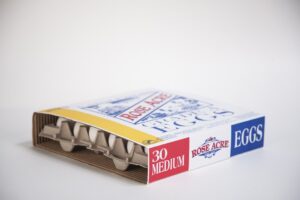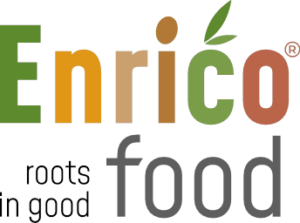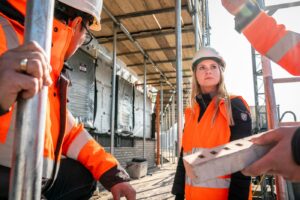People who love animals- love nature.
Family business Vadigran has been producing and supplying pet products of the highest quality since 1955. Once started with the production of grain blends for birds and small animals- Vadigran later expanded its activities to the distribution of accessories and various foods for dogs, cats, small animals, birds, and wild birds.
Vadigran thinks from the needs of both owner and animal. And recently they also combine this with the needs of the planet.
With their mission; ‘creating a more sustainable pet lifestyle’, Vadigran wants to ensure that caring for an animal equals giving back to our planet. Because people who love animals- also love nature.
We strongly believe that if you don’t do this right, you will have no reason to exist in the long run. Or perhaps you will – but just for a very small group of people who keep closing their eyes.
– Wanda Gordts, head of Marketing & Product Development at Vadigran

Translating internal motivation into sustainable action
Vadigran wants to generate sustainable impact and shake up the pet sector. And to do so, they want to create complete transparency in the environmental footprint of all their products.
With large customers such as supermarkets and specialized pet shops, Vadigran believes that it can achieve a major positive impact. So, they started a new sustainability project.
The goal: Within now and 10 years, Vadigran wants its entire range of products to be CO₂-negative. All products in their range will be replaced with sustainable alternatives. At the moment, the focus is on the learning process of measuring their environmental footprint to implement continuous improvement. This is why Vadigran has chosen to first calculate and reduce the environmental footprint of 9 of their own Yana grain products for birds (5 products) and rodents (4 products). This will then be followed by the rest of their product range.
With this goal in mind, they ended up at Ecochain.
We needed a user-friendly platform to be able to calculate the impact of our products ourselves. Ecochain has developed the perfect tools for us to investigate this impact. In addition to access to an extensive database, we also receive personalized advice from environmental specialists. It’s exactly what we need to be able to continue learning about sustainability.
– Kobe Cobbaert, Junior Data analyst at Vadigran

Methodology
The environmental footprints of Vadigran’s 9 own Yana grain products have been calculated through Life Cycle Assessments (LCA). These LCA’s are executed in Ecochain’s product LCA tool Mobius– with the main environmental database Ecoinvent 3.5.
To calculate the individual footprints, the corresponding environmental impact values (Ecoinvent) are linked to each step in the entire life cycle of the 9 grain products. Meaning; from the production of the products until their waste phase- the impact is assessed of the obtaining of raw materials, the necessary transport, the energy consumption, etc.
One of the grain mixtures was first modeled in Mobius by Ecochain to show how the calculations of the products work. With support where necessary, Vadigran now performs all calculations itself.

The result: from environmental data to strategic action points
In the end, the total emissions of the 9 grain products did not disappoint (figure 2). And that’s because the grains are natural products without many processing processes / added ingredients. The LCA’s did show that the biggest impact hotspots of the 9 products are located in:
- The production of raw materials. For example, the production of seeds, kernels, wheat, and oats. Think of agriculture-related impacts such as the use of manure and/or pesticides and energy consumption of agricultural machinery. However, also greenhouse gas emissions (GHG) from fossil energy consumption during production processes, such as the processing of seeds.
- The transport processes. For example via truck and boat. Think of the greenhouse gas emissions that are released over long transport distances.
These ‘environmental hotspot’ insights show Vadigran exactly what they need to focus on to reduce their environmental footprint the most:
(1) Search for alternative raw materials with a lower environmental footprint (through more sustainable agricultural processes or less intensive raw materials).
(2) Shortening transport distances by, for example, working with local suppliers. Or by reducing the weight of the products and finding alternative more sustainable means of transport.

The steps toward climate positive
Sustainability is not just about measuring. Vadigran wants to use the LCA insights strategically for the sustainable development of its entire product portfolio.
With many new products on the horizon, Ecochain will continue to play a supporting role with Mobius. In the end, Vadigran wants to go a step further than CO₂ neutral. They want to constantly improve and work towards a positive climate contribution.
Ecochain allows us to take our product innovations with regard to sustainability seriously. This allows us to communicate transparently about it and be proud of the steps we are taking.
– Kobe Cobbaert, Junior Data analyst at Vadigran

Sustainable product development doesn’t stop
In order to achieve its climate target, Vadigran will continue to measure, compare- and model more and more products in Mobius.
Aditionally:
- The weight of their product’s packaging is already reduced to limit emissions during transport processes.
- The packaging is 100% recyclable through new packaging material with at least 32.6% less CO₂ emissions.
- The CO₂ emissions of the Yana products are transparently communicated to the customer on the packaging (figure 3).
You don’t do sustainability alone
Finally, sustainability in your value chain also means cooperation. Vadigran, wants to involve more and more suppliers & partners in their sustainability journey.
For example, they already work with two partners on reducing shared emissions as much as possible. The remaining emissions? These are compensated by 110% through investments in local projects.
Through Ecochain we learn more about sustainable optimizations every day. As a result, we know for sure that we will do better and better in the future.
– Wanda Gordts, head of Marketing & Product Development at Vadigran




